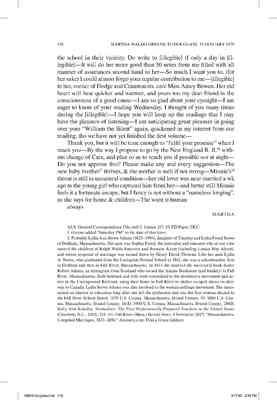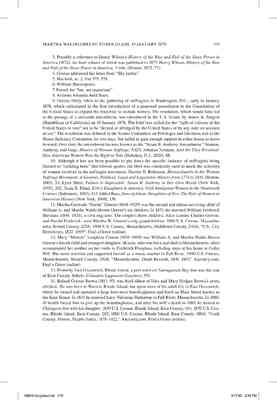Pages
page_0001
MARTHA WALDO GREENE TO FREDERICK DOUGLASS
[East Greenwich, R.I.] 19 January 1878.1Greene added “Saturday PM” to the date of this letter.
MY DEAR FRIEND
I am just home from Lydia Adam’s2Probably Lydia Ann Stowe Adams (1823–1904), daughter of Timothy and Lydia Foord Stowe of Dedham, Massachusetts. Her aunt was Sophia Foord, the naturalist and educator who at one time tutored the children of Ralph Waldo Emerson and Bronson Alcott (including Louisa May Alcott), and whose proposal of marriage was turned down by Henry David Thoreau. Like her aunt Lydia A. Stowe, who graduated from the Lexington Normal School in 1841, she was a schoolteacher, first in Dedham and then in Fall River, Massachusetts. In 1844 she married the successful book dealer Robert Adams, an immigrant from Scotland who owned the Adams Bookstore (and bindery) in Fall River, Massachusetts. Both husband and wife were committed to the abolitionist movement and active in the Underground Railroad, using their home in Fall River to shelter escaped slaves on their way to Canada. Lydia Stowe Adams was also involved in the woman suffrage movement. She maintained an interest in education long after she left the profession and was the first woman elected to the Fall River School Board. 1870 U.S. Census, Massachusetts, Bristol County, 39; 1880 U.S. Census, Massachusetts, Bristol County, 161D; 1900 U.S. Census, Massachusetts, Bristol County, 286B; Kelly Ann Kolodny, Normalites: The First Professionally Prepared Teachers in the United States (Charlotte, N.C., 2014), 124–64; Fall River (Mass.) Herald News, 4 November 2017; “Massachusetts, Compiled Marriages, 1633–1850,” Ancestry.com; Find a Grave (online). where we have been reading “The Rise and Fall of the” &c.3Possibly a reference to Henry Wilson’s History of the Rise and Fall of the Slave Power in America (1872), the final volume of which was published in 1877. Henry Wilson, History of the Rise and Fall of the Slave Power in America, 3 vols. (Boston, 1872–77). In my attic chambers4Greene addressed her letter from “Sky parlor.” I have started a file and shall make sure of a little chat with you before consigning myself to the good Goddess who administers the “balm of hurt minds”5Macbeth, sc. 2, line 575, 578. and “Knits up the ravelled sleeve of Care”—With grateful heart, no I haven’t the right—<according to the meaningful bard> sleep is itself the balm of hurt minds.6William Shakespeare. I was going to say, that I seek his aid as “laid nature’s sweet gesture” to this than for her balm—because I haven’t the “hurt mind.” Mais n’importe—7French for “but, not important.”
I was glad of your referring to your visit to Mrs Sears8Arianna Amanda Auld Sears.—and shall be more glad of a further report when we meet. I realize now more than I did when I wrote before, how much I have missed by not being in Washt. during the W. Suffrage Convention9Greene likely refers to the gathering of suffragists in Washington, D.C., early in January 1878, which culminated in the first introduction of a proposed amendment to the Constitution of the United States to expand the franchise to include women. The resolution, which would have led to the passage of a sixteenth amendment, was introduced in the U.S. Senate by Aaron A. Sargent (Republican of California) on 10 January 1878. The brief text called for the “right of citizens of the United States to vote” not to be “denied or abridged by the United States or by any state on account of sex.” The resolution was debated in the Senate Committee on Privileges and Elections and in the House Judiciary Committee for two days, but failed to gain enough support in either house to move forward. Over time the amendment became known as the “Susan B. Anthony Amendment.” Stanton, Anthony, and Gage, History of Woman Suffrage, 5: 623; Johanna Neuman, And Yet They Persisted: How American Women Won the Right to Vote (Hoboken, N.J., 2020), 88.—I think I can understand well the treatment shown them in the House, from having seen how our R. I. legislatures thought it very smart in them to call them “cackling hens” &c.10Although it has not been possible to pin down the specific instance of suffragists being likened to “cackling hens” that Greene quotes, the libel was commonly used to mock the activities of women involved in the suffragist movement. Harriet H. Robinson, Massachusetts in the Woman Suffrage Movement: A General, Political, Legal and Legislative History from 1774 to 1881 (Boston, 1883), 24; Lynn Sherr, Failure Is Impossible: Susan B. Anthony in Her Own Words (New York, 1995), 202; Hasia R. Diner, Erin’s Daughters in America: Irish Immigrant Women in the Nineteenth Century (Baltimore, 1983), 143; Ishbel Ross, Sons of Adam, Daughters of Eve: The Role of Women in American History (New York, 1969), 158. I am hoping it will not be many weeks before we can talk of all these things together. Gertie11Martha Gertrude “Gertie” Greene (1848–1929) was the second and oldest-surviving child of William A. and Martha Waldo Brown Greene’s six children. In 1872 she married William Frederick Sherman (1848–1926), a civil engineer. The couple’s three children, Alice Louise, Charles Greene, and Harold Frederick, were Martha W. Greene’s only grandchildren. 1880 U.S. Census, Massachusetts, Bristol County, 225A; 1900 U.S. Census, Massachusetts, Middlesex County, 246A; “U.S., City Directories, 1822–1995”; Find a Grave (online). is instituting steps for obtaining a “maid of all work,” to take position when her sister12Mary “Minnie” Josephine Greene (1856–1909) was William A. and Martha Waldo Brown Greene’s fourth child and youngest daughter. Minnie, who was born and died in Massachusetts, often accompanied her mother on her visits to Frederick Douglass, including stays at his home at Cedar Hill. She never married and supported herself as a music teacher in Fall River. 1900 U.S. Census, Massachusetts, Bristol County, 191B; “Massachusetts, Death Records, 1841–1915,” Ancestry.com; Find a Grave (online). leaves, and as soon as things are in good running order, I hope to be with you. There seems but one probable hindrance. I wrote you of my going to Greenwich13Probably East Greenwich, Rhode Island, a port town on Narragansett Bay that was the seat of Kent County. Seltzer, Columbia Lippincott Gazetteer, 551. when in Providence to see my brother.14Roland Greene Brown (1811–93) was third oldest of John and Mary Hodges Brown’s seven children. He was born in Warren, Rhode Island, but spent most of his adult life in East Greenwich, where he owned and operated a large four-story boardinghouse and hotel on Main Street known as the Kent House. In 1841 he married Lucy Valentine Hathaway in Fall River, Massachusetts. In 1880, ill health forced him to give up the boardinghouse, and after his wife’s death in 1885, he moved to Chicago to live with his daughter. 1850 U.S. Census, Rhode Island, Kent County, 454; 1870 U.S. Census, Rhode Island, Kent County, 203; 1880 U.S. Census, Rhode Island, Kent County, 180A; “Cook County, Illinois, Deaths Index, 1878–1922,” Ancestry.com; Find a Grave (online). He has been in a very excited condition, and I may be called there, but his trouble is an old chronic ill, which has lately <grown> worse and threatened an immediate “taking off,”—but he had rallied a week ago when I heard from him—and may perhaps regain his old ground—Aunt Lucretia15Lucretia Hodges (1797–1889) was the youngest sibling of Mary Hodges Brown (1780–1847), Martha W. Greene’s mother. She was sixteen years younger than Mary Hodges Brown and seems to have spent most of her life living with family members in Rhode Island. Hodges, who never married, died and was buried in Providence in 1889. Almon D. Hodges, Jr., comp., Genealogical Record of the Hodges Family of New England (Boston, 1896), 158, 275; “Rhode Island, U.S., Death Index, 1630–1930”; Find a Grave (online). has never had another ill turn, since the night we came from Greenwich. It seems wonderful. I have heard nothing from Chicago, or directly from [illegible], since we were there. Indirectly I have heard that [illegible] interesting (!) & he is to marry the young lady who teaches
page_0002
the school in their vicinity. Do write to [illegible] if only a day in [illegible]—It will do her more good than 50 notes from me filled with all manner of assurances second hand to her—So much I want you to, (for her sake) I could almost forgo your regular contribution to me—[illegible] to her, corner of Dodge and Cranston sts. care Miss Amey Bowen. Her old heart will beat quicker and warmer, and yours too my dear friend in the consciousness of a good cause—I am so glad about your eyesight—I am eager to know of your reading Wednesday. I thought of you many times during the [illegible]—I hope you will keep up the readings that I may have the pleasure of listening—I am anticipating great pleasure in going over your “William the Silent” again, quickened in my interest from our reading, tho we have not yet finished the first volume—
Thank you, but it will be time enough to “fulfil your promise” when I reach you—By the way I propose to go by the New England R. R.16Possibly a reference to the New York & New England Railroad, which was one of only three lines that linked Boston, Massachusetts, directly to New York City. The line also connected Hartford, Connecticut, and Providence, Rhode Island, to Boston. The New York & New England ran two trains from Boston to New York City daily (sharing the line into New York with the New Haven Railroad): the New England Limited, also known as the White Train, which provided passengers with luxury accommodations, and the Mid-Day Express. The New York & New England opened in 1871 and operated until 1893, when the company was forced into bankruptcy. Under new management, the line reopened in 1895, renamed the New England Railroad. Lawrence Walsh, The Battle for Transportation Supremacy: How the Titans of Transportation Positioned Their Companies Over the Past 170 Years in the Boston to New York Corridor (Bloomington, Ind., 2014), 33–34, 40–41; Albro Martin, Railroads Triumphant: The Growth of a Vital American Force (New York, 1992), 67. without change of Cars, and plan so as to reach you if possible not at night— Do you not approve this? Please make any and every suggestion—The new baby brother17Martha W. Greene’s grandson Charles Greene Sherman (1878–1956) was born on 3 January 1878. He was her second grandchild and the younger brother of Alice Louise Sherman. Sherman spent most of his adult life working as an engineer while living in Malden, Massachusetts. 1880 U.S. Census, Massachusetts, Bristol County, 225A; 1910 U.S. Census, Massachusetts, Suffolk County, 120A; “U.S., City Directories, 1822–1995.” thrives, & the mother is well if not strong—Minnie’s18Mary “Minnie” Josephine Greene. throat is still in unnatural condition—her old lover was near married a wk ago to the young girl who captured him from her—and better still Minnie feels it a fortunate escape, but I fancy is not without a “nameless longing”, as she says for home & children—The want is human
always
MARTHA
ALS: General Correspondence File, reel 3, frames 217–19, FD Paper, DLC.



